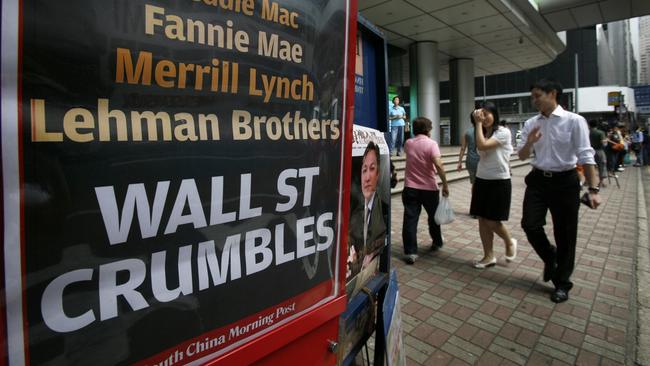How to survive the next Global Financial Crisis
SCARS still run deep from the Global Financial Crisis, and learning from the collapse of the world’s markets and companies is critical for our future.
EXACTLY 10 years ago the collapse of US banking giant Lehman Brothers helped send the world spiralling deep into the global financial crisis.
Lehman, the biggest bankruptcy in US history, intensified fears that the world’s financial system was on its deathbed, and share markets sunk by more than half. Many people lost their life savings and homes as world sunk into recession.
Australia narrowly escaped a recession but financial gloom swept over us, and the scars among investors and super fund members who lost piles of money still run deep.
MORE: Investors look beyond big blue chips
Millions of words have been written about the GFC but, a decade later, relatively few about what to do when it happens again.
Markets crash when we least expect them, and some forecasters say booming US stocks are due for a tumble that would flow through to us.
Lessons from the GFC can help us prepare better for the next collapse. Lessons like these:

1. AVOID KNEE-JERK REACTIONS
Many investors sell at the bottom and buy at the top, just before asset prices fall again. It’s the common herd mentality that’s extremely tough to resist.
Investors and super fund members who moved everything to cash at the low point of the GFC were pummelled out by a one-two punch — they lost half of their assets in the fall, then completely missed out of the rebound.
Superannuation industry group ASFA says someone who switched to cash back then has only grown their investment by 10 per cent since, while balanced super fund investments have grown 85 per cent and growth funds 90 per cent in the past decade.
2. INVEST LIKE BUFFETT
Warren Buffett is the world’s richest share investor and one of his most popular quotes is “be fearful when others are greedy and be greedy when others are fearful”.
If you nail this, you get great profits. Once the Aussie sharemarket bottomed out in March 2008, it surged more than 55 per cent over the next nine months.
Timing it right requires extreme luck or a crystal ball, so aim to make small regular investments in strong companies that are undervalued.
3. DON’T TRY TO CATCH FALLING KNIVES
I personally failed dismally at knife catching during the GFC. After Aussie shares had tumbled 25 per cent by mid-2008 I bought up big — using borrowed money — while thinking “surely it can’t go any lower”. Err, try another 30 per cent lower.
This is why making small regular investments — known as dollar cost averaging — is a successful strategy for investors.
4. DIVERSIFY
Holding a diverse range of assets is one of the best ways to protect wealth.
On the sharemarket today you can invest in government bonds, local and global shares, corporate debt, all types of real estate everywhere and commodities such as gold.
You’ll have to do research, seek advice if unsure, and don’t put too many eggs in one basket.
Importantly, have a plan about how you will react to a fresh financial crisis well before the next one strikes.
